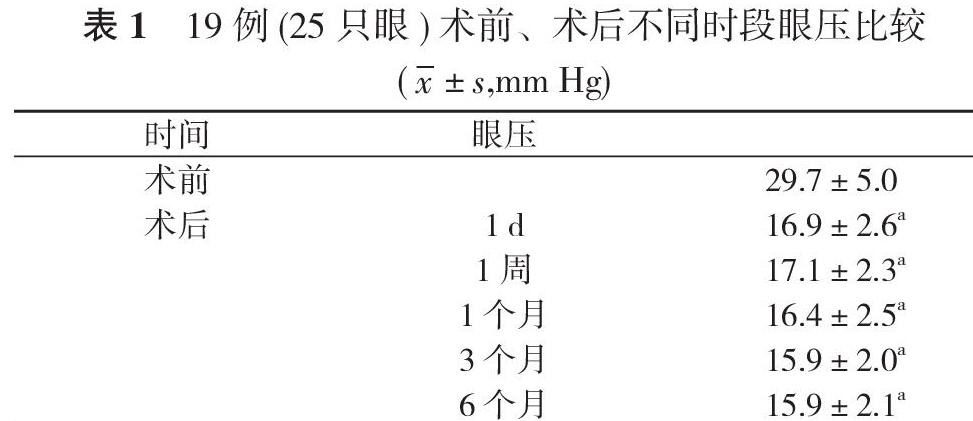白内障摘除联合直接房角镜下钝性机械性房角分离术治疗滤过失败闭角型青光眼的疗效观察
蔺云霞 夏阳 李军 郭素平 徐玲

【摘要】 目的 觀察白内障摘除联合直接房角镜下钝性机械性房角分离术治疗传统小梁切除术后失败的闭角型青光眼的疗效。方法 19例(25只眼)传统小梁切除术后失败的闭角型青光眼患者, 均行超乳白内障摘除术联合人工晶体植入及直接房角镜下钝性机械性房角分离术, 若虹膜括约肌受损严重, 瞳孔散大>4.5 mm, 同期行瞳孔缩小术。术后随访6个月, 记录术前、术后不同时段眼压、最佳矫正视力, 并比较;分析房角开放程度、并发症发生情况。结果 术前眼压为(29.7±5.0)mm Hg(1 mm Hg=0.133 kPa), 术后1 d、1周、1个月、3个月、6个月分别为(16.9±2.6)、(17.1±2.3)、(16.4±2.5)、(15.9±2.0)、(15.9±2.1)mm Hg, 术后各时段眼压均低于术前, 差异具有统计学意义(P<0.05)。术前房角开放程度均<60°, 术后1个月房角镜检查房角开放程度均>270°。有2例角膜水肿, 对症治疗, 3~5 d后角膜恢复透明;有1例前房积血, 通过前房冲洗及止血治疗1周好转;5例因行瞳孔缩小成型, 术后炎症反应明显, 局部加大激素治疗好转, 无其他严重并发症发生。术前、术后1个月最佳矫正视力比较, 差异具有统计学意义(P<0.05)。结论 白内障摘除联合直接房角镜下钝性机械性房角分离术治疗传统小梁切除术失败的闭角型青光眼具有眼压控制好、并发症少等优点, 且同时行白内障及瞳孔缩小术, 视力及视觉质量得到恢复。
【关键词】 房角分离术;白内障超声乳化摘除术;小梁切除术失败;闭角型青光眼
【Abstract】 Objective To observe the efficacy of cataract extraction combined with blunt mechanical angle separation under direct gonioscopy in the treatment of angle-closure glaucoma after failed trabeculectomy. Methods A total of 19 patients (25 eyes) with angle-closure glaucoma who failed after trabeculectomy underwent phacoemulsification combined with intraocular lens implantation and blunt mechanical atrial angle separation under direct gonioscopy. If the iris sphincter was seriously damaged, and the pupil dilatation >4.5 mm, pupil reduction was performed at the same time. The patients were followed up for 6 months. The intraocular pressure and best corrected visual acuity were recorded and compared before and after operation. The degree of chamber angle opening and complications were analyzed. Results The preoperative intraocular pressure was (29.7±5.0) mm Hg, and (16.9±2.6), (17.1±2.3), and (16.4±2.5), (15.9±2.0), and (15.9±2.1) mm Hg in 1 d, 1 week, 1 month, 3 months and 6 months after operation, intraocular pressure at each time after operation was lower than those before operation. The difference was statistically significant (P<0.05). The opening degree of chamber angle was <60° before operation, and the opening degree of anterior chamber angle was >270° 1 month after operation by gonioscopy. There were 2 cases of corneal edema, and the cornea recovered transparent after 3~5 d of symptomatic treatment. 1 case of hyphema improved after one week of anterior chamber irrigation and hemostasis. 5 cases had obvious inflammation after pupil reduction, which was improved by local incremental hormone therapy. No other serious complications occurred. There was statistically significant difference in the best corrected visual acuity before and 1 month after surgery (P<0.05). Conclusion Cataract extraction combined with blunt mechanical angle separation under direct gonioscopy in the treatment of angle-closure glaucoma with traditional trabeculectomy failure has the advantages of good intraocular pressure control and fewer complications. At the same time, cataract and pupil reduction were performed, and visual acuity and visual quality were restored.
【Key words】 Angle separation; Phacoemulsification of cataract; Trabeculectomy failure; Angle-closure glaucoma
小梁切除术作为治疗各类青光眼最常用手术, 其治疗效果被国内外学者广泛认同, 但其术后不可避免的滤过通道瘢痕阻塞问题到目前为止仍然是困扰青光眼医生的一大难题[1]。手术后2年的失败率可达15%~30%。超声乳化联合房角分离术治疗一些晶体悬韧带功能差、不全脱位或膨胀、仅有虹膜膨隆或房角粘连较轻范围小、发病时间短的闭角型青光眼疗效已获得眼科专家的公认[2, 3]。但是关于滤过术失败闭角型青光眼治疗方法的报道很少。本文回顾了本院采用白内障摘除联合钝性机械性房角分离术治疗的19例患者进行分析。现报告如下。
1 资料与方法
1. 1 一般資料 收集2015~2017年于本院就诊的传统小梁切除术后失败的闭角型青光眼患者19例(25只眼), 其中男5例(7只眼), 女14例(18只眼), 平均年龄(65.58±4.58)岁。患者均合并有不同程度晶状体混浊, 视力≤0.5, 被诊断为白内障。
1. 2 入选标准 ①所有患者均为闭角型青光眼小梁切除术术后;②根据KIM标准判定为条件成功和失败病例, 即眼压>21 mm Hg或者应用降眼压药物后<21 mm Hg。③术前房角镜及超声生物显微镜(UBM)检查, 周边房角粘连关闭>270°。排除患有其他眼科疾病影响手术疗效, 或影响预后的全身疾病及手术禁忌证患者。
1. 3 方法 记录患者基本信息、病史、用药史(包括术前使用青光眼药物名称及次数)等既往病史, 完善术前及研究需要检查。由同一术者行超声乳化白内障摘除术人工晶体植入联合直接房角镜下钝性机械房角分离术, 术前发现虹膜括约肌受损严重导致瞳孔直径>4.5 mm, 或者瞳孔区虹膜后粘连患者同时行瞳孔缩小术。术后常规护理, 给予全身及局部激素配合结膜下注射激素等对症抗炎治疗, 辅以常规抗生素眼药水预防感染。
1. 4 观察指标 对术前、术后不同时段眼压、前房角开放程度、并发症发生情况及矫正视力等其他指标进行观察记录, 比较术前、术后眼压, 最佳矫正视力随访6个月。
1. 5 统计学方法 采用SPSS17.0统计学软件对数据进行统计分析。计量资料以均数±标准差( x-±s)表示, 采用t检验;计数资料以率(%)表示, 采用χ2检验;等级资料采用Wilcoxon符号秩和检验。P<0.05表示差异具有统计学意义。
2 结果
2. 1 术前、术后不同时段眼压 患者术后1 d、1周、1个月、3个月、6个月眼压均低于术前, 差异具有统计学意义(t=11.356、11.447、11.896、12.813、12.723, P<0.05)。见表1。
2. 2 房角开放程度 术前房角开放程度均<60°, 术后1个月房角镜检查房角开放程度均>270°。
2. 3 并发症发生情况 有2例角膜水肿, 对症治疗, 3~5 d后角膜恢复透明;有1例前房积血, 通过前房冲洗及止血治疗1周好转;5例因行瞳孔缩小术, 术后炎症反应明显, 局部加大激素治疗好转, 无其他严重并发症发生。
2. 4 最佳矫正视力 25只眼(100.0%)术后1个月最佳矫正视力均有不同程度提高;术前, 25只眼最佳矫正视力<0.1、0.1~0.2、0.2~0.3、0.3~0.4、0.4~0.5、0.5~0.6、0.6~0.7、0.7~0.8分别为14、5、4、2、0、0、0、0只, 术后1个月分别为1、2、6、8、3、3、1、1只。术后1个月, 患者最佳矫正视力优于术前, 差异具有统计学意义(Z=-4.373, P<0.05)。
3 讨论
房角分离术只要做到明确房角开放, 即可以开放重建原有的滤过通道, 实现眼压的控制[4]。其具有不改变原有解剖结构, 术后很少发生滤过过强、浅前房、恶性青光眼、滤过通道瘢痕化、滤过泡相关并发症的优点。因此本文采用超声乳化白内障摘除人工晶体植入联合直接房角镜下钝性机械性房角分离术治疗小梁切除术后眼压失控合并有白内障闭角型青光眼患者, 患者均曾行小梁切除术, 术后滤过泡失败眼压再次升高, 房角检查均有>270°粘连关闭, 药物难以控制达到靶眼压, 以往均被归类难治性青光眼。
该方法优势在于房角镜直视, 粘弹剂保护下钝性机械性360°分离房角, 直到可见睫状体带, 可以直观确保功能小梁的重新暴露, 避免了机械分离造成房角撕裂、睫状体脱离、虹膜根部撕裂的可能[5, 6], 大大减少了术中并发症及术后炎症反应。
本次研究结果显示, 所有患者术后房角均>270°开放, 术后不同时间阶段眼压均得到明显有效控制。因同期白内障手术及部分患者同期瞳孔缩小术, 所有患者术后视力均提高。同期瞳孔缩小术将急性发作或手术刺激等原因造成堆积在房角的无张力虹膜组织进行了向心性收缩缝合, 即提高了视觉质量, 也阻止了再次粘连, 保障房角开放, 虽因损伤虹膜, 炎症反应较重, 少数有出血, 但术后用药均可控制[7, 8]。若合并眼底疾病, 后期治疗会因瞳孔成型受限制, 此类患者需要慎重选择此术式。
综上所述, 白内障超乳摘除联合直接房角镜下钝性机械性房角分离术治疗传统小梁切除术后失败的闭角型青光眼患者, 具有眼压控制好、并发症少且改善患者视力及视觉质量等疗效。
参考文献
[1] Wilson ME, Gupta P, Tran KV, et al. results from a modified bleb needling procedure with continuous infusion performed in the operating room. Journal of Glaucoma, 2016, 25(9):720-726.
[2] 陳彦霓, 陈子林. 抗VEGF药物治疗新生血管性眼病的现状与展望. 医学综述, 2016, 22(8):1550-1553.
[3] Niwas SI, Lin W, Bai X, et al. Automated anterior segment OCT image analysis for Angle Closure Glaucoma mechanisms classification. Computer Methods & Programs in Biomedicine, 2016, 130(C):65-75.
[4] Wang J, Barton K. Aqueous shunt implantation in glaucoma. Taiwan Journal of Ophthalmology, 2017, 7(3):130-137.
[5] Chen WQ, Jhanji V, Chen HY, et al. Visual impact of sub-Tenon anesthesia during combined phacoemulsification and vitrectomy surgery. International Journal of Ophthalmology, 2016, 7(2):860-863.
[6] Tayyab H, Khan AA, Javaid RMM. Clinical outcome of 23g Trans-Conjunctival pars plana vitrectomy - a prospective comparison of Phaco-Vitrectomy with only vitrectomy in phakic eyes. Pakistan Journal of Medical Sciences, 2017, 33(5):1123-1127.
[7] Tomilova E, Shukhaev S. A novel method to compare phacoemulsification parameters in vivo: two halves of one nucleus. Graefes Archive for Clinical & Experimental Ophthalmology, 2016, 254(8):1579-1584.
[8] Wagenfeld L, Hermsdorf K, Stemplewitz B, et al. Refractive predictability in eyes with intraocular gas tamponade - results of a prospective controlled clinical trial. Clinical Ophthalmology, 2017, 11:993-998.
[收稿日期:2018-11-22]

